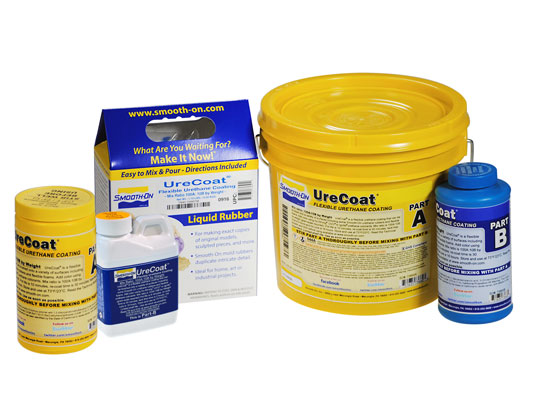UreCoat™
UreCoat™ is a two component urethane (A+B) that can be mixed and brushed onto a variety of surfaces to provide a flexible, tough and impact resistant coating. Mix ratio is 100A:10B by weight (gram scale required), pot life is 8 minutes, re-coat time is 30 minutes, tack free time is 2 hours and full cure is 16 hours at 73°F/23°C. UreCoat™ contains no phthalates or VOC's.
Features
- Adhesive - UreCoat™ will bond to many surfaces and can be used as a flexible coating for expanded polystyrene (EPS foam), fabric, some metals and plastics, wood, rope and more.
- Strong - Cured rubber is tough and UV resistant. UreCoat™ has been used to repair damaged or deteriorated latex animatronic skins, masks, etc.
- Color Neutral - Use as a Flexible Paint Base: UreCoat™ is easily colored with SO-Strong™, UVO™ or Ignite™ colorants to create a permanent paint for coating cured Smooth-On urethane rubbers or flexible foams. Cured UreCoat™ will bend and flex with the rubber or foam part.
- Create a Matte Surface - You can create a matte finish using UreCoat™ Matting Powder
FOR COMMERCIAL/INDUSTRIAL USE ONLY
Instructions
Amount to Mix and Apply at One Time - Because this is a coating, a small amount goes a long way. Mix only what you can comfortably brush on to your target surface in 8 minutes before material sets up.
Measuring and Mixing - Before you begin, pre-mix Part B thoroughly to re-disperse components that may have settled. A gram scale is required to accurately measure 100 Parts A to 10 Parts B. After dispensing into a mixing container, mix thoroughly for 2 - 3 minutes using a square edged mixing stick. Aggressively scrape the sides and bottom of the mixing container several times. Use the square edge of the stick to bring material off of the sides of the container and blend.
Extending Working Time - Reduce the mass of the mixture to increase working time. Example: layer two sheets of aluminum foil together and create a single-use flat tray with vertical sides to contain the liquid. After mixing parts A and B, pour mixture into the aluminum foil to reduce the mass. Your working time will be significantly increased. Applying - Apply a thin layer to the surface, making sure there are no brush strokes. Wait 30 minutes for material to partially cure and apply a second layer. Subsequent layers can be added as desired.
Thinning - To thin UreCoat™, the recommended mix ratio is 100 Parts A + 10 Parts B + 25 or more Parts of 99% isopropyl alcohol or acetone depending on the application. Pre-mix solvent into Part A before adding Part B. Observe all safety precautions when handling solvents. Mix thoroughly to a uniform color (no streaks).
Thickening - UreCoat™ can be thickened to a paste-like consistency for brushing or troweling onto surfaces. Ure-Fil™ 11 is an effective filler for thickening this material. The recommended maximum filler load when using Ure-Fil™ 11 is 100 parts UreCoat™ Part A to 10 parts UreCoat™ Part B to 15 parts filler by weight. Ensure filler is dry, and pre-mix filler with Part A before combining with Part B.
Surface Finish - UreCoat™ UreCoat™ will cure with a high gloss surface finish. If a matte surface finish is desired, we recommend using UreCoat™ Matting Powder to create a permanent matte finish. UreCoat™ Matting Powder is combined with solvent and UreCoat™ which results in a long-lasting matte surface once the UreCoat™ is cured. See the UreCoat™ Matting Powder TB for more information.
Curing - Allow UreCoat™ to cure overnight (at least 16 hours) at room temperature (73°F/23°C) before handling. Full cure time can be reduced heating the material 150°F/60°C for 4 hours. Allow UreCoat™ to come to room temperature before handling. Clean Up - Gently scrape as much uncured material from surface as possible with flat edge tool. Remove remaining uncured UreCoat™ with alcohol.
Related Categories: Urethane Rubber, Epoxy and Urethane Coatings
Related Series: UreCoat™ – Flexible Urethane Coating
How-To Articles

How To Make a Foam Prop Sword Using a Silicone 2 Part Mold
How a 3D printed master is used to pour a silicone mold for a prop sword

How To Repair a Latex Animatronic Prop Using UreCoat™
Watch how a haunted attraction completely repaired a damaged latex animatronic prop
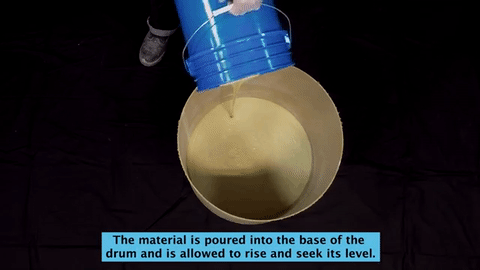
How To Make a Custom Foam Seat Using Pourable Urethane Foam
Pourable polyurethane foam materials are used to create a unique piece of custom furniture.
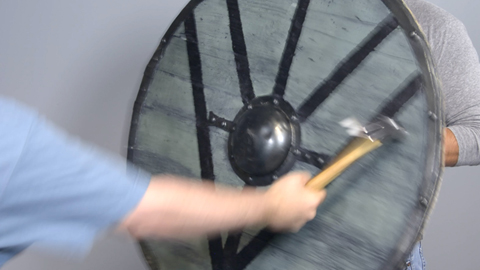
How To Make an Impact Resistant Cosplay Prop Viking Shield Using UreCoat™
This video tutorial shows how to make a prop shield for theater or cosplay using pourable foam and UreCoat® urethane coating.
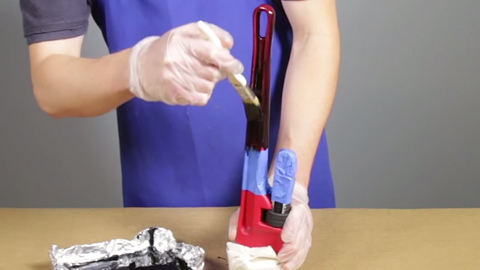
How To Make Rubber Grips Using UreCoat™ Coating
This video tutorial shows how to use UreCoat® to coat tool handles. The coated handles are easier to hold and safer to handle.
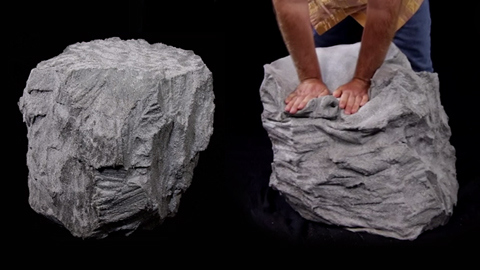
How To Make an Indestructible Prop Using UreCoat™
This video tutorial shows how to make a fake foam prop rock using carved soft foam and UreCoat® urethane coating.
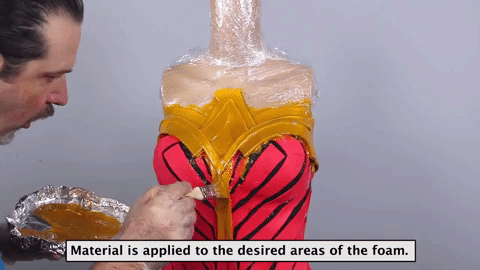
How To Make a Wonder Woman Cosplay using UreCoat™
How to make costume armor using craft foam and Smooth-On's UreCoat
